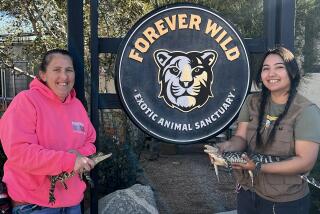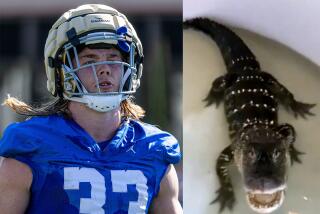A Pair of Yellow Eyes and a .44
- Share via
GROSSE TETE, La. — There is no easy way to get to Smith Lake. The road ends half a mile away, beside a narrow channel dense with waterlilies. When the hunters slide their skiff into the canal, the whole swamp billows beneath them like a curtain at an open window.
After that they enter a long corridor. The water is gray-brown, as thick as sauce, and the air has the sweet-foul smell of swamp gas. Around them, everything twitches: The wings of dragonflies tremble, spiders skitter over the water, and sunlight flickers through a tangle of plants overhead. The hunters get out and push.
Finally they see the open water of the lake. They stand motionless before the water, and its surface is broken by the black-ridged back of a 10-foot alligator. Another slides by, this one 8 feet long, judging by the distance from eye to nostril.
The lake is on private property, and is so secluded that no one has hunted here for 11 years. Blinking knots poke out of the scum at the water’s edge. Trails of bubbles curve across the surface and then vanish.
It is a good day to be an alligator hunter.
Like every other industry in south Louisiana, the alligator business was bruised by this fall’s back-to-back hurricanes. Salt water rolled into farmers’ pens, allowing about 1,000 hatchlings to escape, and saturated the marshland where alligators will build their nests next summer. It threatened to swamp storehouses where alligator skins waited -- cooled, salted and rolled in barrels -- for purchase by fashion houses in France and Italy. After the storms, with anxiety high among buyers, the going price for wild alligator skin rose to $36 per foot, $10 higher than last year’s price.
And so, last week, Larry Dees decided it was worth the effort to reach Smith Lake, deep in the marsh west of Baton Rouge. Alligator hunting is an age-old skill in these parts; Cajun men reminisce about the days when it was a way to support a family.
In the 1960s, with the wild alligator population dwindling, hunting was banned. Since then, it has been phased back in, but under strict control of game wardens, who allocate tags to property owners based on the density of the alligator population. For a month every year, those hunters lucky enough to get tags from landowners set out for the swamps, just like the old days.
Carrying their tags in a pouch, Dees and his two assistants took a good, long look around Smith Lake. Jeff Brown, whose regular job is selling insurance, pulled out a handgun and shot a 4 1/2 -foot alligator in the head. It jerked in the water, and Brown, 35, waded through the lake and picked it up by the tail. He threw it in the boat. He was not impressed.
“That,” he said, “is a po’ boy and a wallet.”
It wasn’t 4-footers they had come for. Guiding the 18-foot skiff around the shoreline, Dees stopped the boat at regular intervals. At each stop, Travis Dardenne, an electrician, jammed a long bamboo pole into the muck at an angle, so it jutted over the water.
Then he took a length of rope. One end he tied firmly to a tree limb, the other he attached to the bamboo pole, so that a curved steel hook was suspended above the water. From a cooler, he took a hunk of raw chicken and speared it onto each hook -- high enough so that only larger alligators would be able to jump out of the lake to reach it.
As afternoon turned to night, the hunters had gone again, leaving the spot as wild and quiet as it had been for the last 11 years. The chicken pieces dangled, dripping, several feet above Smith Lake.
The alligator has survived almost unchanged since the age of the dinosaur. When threatened, or when attacking prey, an alligator will clench another animal between its teeth and go into a “death roll,” designed to stun its prey or twist off an appendage.
Once an alligator’s jaws snap shut, it is nearly impossible to break its hold. A researcher at Florida State University recently tested the bite force of a 12-foot alligator and measured it at 2,215 pounds, about the weight of a small car.
These defensive tools, however, do not help an alligator that has swallowed a hook attached to a length of rope. Alligators gulp their food without chewing, so they typically ingest the hook, which comes to rest deep inside the stomach. When they realize they are stuck, alligators react by rolling, which entwines them in the rope.
By the time hunters return, they have crawled, exhausted, to the shoreline.
Dees, who grew up in nearby Maringouin, has bright blue eyes and a drooping white handlebar mustache. He gauges oil wells for a living, but hunts when he gets the chance, selling the hides and guiding trips for paying tourists. At 54, he is nimble enough to jump up on the rim of his aluminum boat and run back and forth between bow and stern without tipping it.
He is not afraid of alligators. Greg Dupont, who owns the excursion business Louisiana Hunters Inc., recalls a trip they guided for a hunter who shot a 10-foot alligator twice in the eye without killing it. Dees was so frustrated that he jumped into the water, grabbed the stunned alligator around the tail, hauled it to shore and shot it himself. The alligator weighed, conservatively, five times as much as Dees did. Dupont describes his friend as “plumb nuts.”
Dees isn’t one to tell war stories. He twinkles while other people tell them.
“You don’t want no part of a 4-foot alligator,” he said. “They get ahold of you, they’ll rip you.”
Dees steered the skiff back to Smith Lake just before 9 a.m. on Saturday, this time carrying Dardenne and two customers -- a video-store owner from Saskatchewan and his son, who had paid $3,500 for three days of swamp hunting.
After the previous day’s tour of the spot, Dees was not sure what to expect: Would the alligators swim by the boat, curious and unafraid, as they did Friday? Or would they already be spooked, apprehensive around people?
They reached the lake to find nothing but dragonflies wheeling in the haze over calm water. They checked the hooks and found the first hunk of chicken trailing in the lake. When they approached the second hook, they saw something rustling in the bushes. Dardenne pulled in the line, and suddenly they were face to face with a pair of yellow eyes.
There’s only one shot that can kill a swimming alligator -- at the edge of a bony plate on the top of its head, straight into its walnut-sized brain pan. Its skull is so tough that if you shoot too far forward, the bullet could ricochet and hit you. Aim badly and an alligator could survive a bullet from a .44 magnum. Aim well, Dupont said, and you could kill it with a ball-peen hammer.
The video-store owner fired twice. As the alligator turned over, webbed claws appeared above the surface of the water. A plump-looking knee bobbed up.
It was the first of eight kills. One alligator arched its back as it died, exposing a length of creamy white belly, the piece of skin most valued by apparel manufacturers. Another butted the side of the skiff with a bang, its tail churning the water.
The real work for hunters is retrieving the bodies. Dardenne grabbed them by the legs and hauled their bodies over the side. The longest was more than 8 feet, and at least 300 pounds. It is difficult to tell whether an alligator is alive or dead -- they are known for rearing up suddenly in the boat -- and Dardenne poked them hard in the eye to make sure. These were dead, but their back legs pumped sporadically for the next hour, scratching at the aluminum side of the boat.
Shortly before 10 a.m., the hunters passed around cans of cold beer and cracked them open.
The Canadians were happy, but Dees was scanning the water. He had been watching a trail of bubbles on the surface, so wide that he was certain that the animal on the lake floor was more than 10 feet long.
It’s rare to catch an alligator longer than that, not only because there are fewer but because they are far older -- the lake’s great survivors -- and the task becomes exponentially more difficult. “They didn’t get big by being dumb,” Dees said.
For a commercial hunter, most of the business is 7- or 8-foot alligators, but it’s the big ones that will be talked about at the gas station over lunch. The big ones make reputations.
As they passed a stretch of lilies, Dees’ eyes darted around, and he spoke in the crooning falsetto he reserves for alligators. There’s something under there.
“It might be the good one,” he said. “It might be the big boy.”
But the water stilled. The hunters headed out of the channel shortly before lunchtime, their skiff now loaded with several thousand pounds of dead weight.
They hoisted the alligators into the back of Dardenne’s truck and covered them with a cool, wet sheet; if they get too hot, their scales begin to slide off, and the hide is useless.
One of the tourists explained what he liked that morning: the sensation of not knowing what’s under the water.
Dees knew exactly what he meant.
“It’s kind of like a box of chocolates,” he said.
It had been a good morning, everyone agreed. The eight bodies were thrown, with a loud slap, to the concrete outside the bait shop, where they were measured, tagged and entered in a logbook that will be given to the state Department of Wildlife and Fisheries.
The meat will be sold to a dealer, and the skin will wind up in the hands of tanners, who will take thick, briny-smelling hides and soak them in a sulfur solution, bleach the last trace of color out of them, shave them to a velvet softness, and buff them to a high gloss with a spinning stone before shipping them to luxury manufacturers in Europe.
That, however, couldn’t have been further from Dees’ mind on a Saturday morning in late September.
For him, it was hard not to think about the big alligators -- the truly big alligators -- under there somewhere, gliding in the lilies, surviving to see another year.
Dees knows alligators, and, as the lake receded behind the skiff, he said he could almost hear them laughing.
*
(BEGIN TEXT OF INFOBOX)
Got gator?
The vast majority of alligator skins harvested in Louisiana are from farmed animals rather than wild ones. Here’s a look at gators tagged in 2001 and where the skins ended up:
Wild: 37,981
- France 50%
- Singapore 25%
- U.S. 25%
*
Farmed: 179,701
- France 35%
- U.S. 29%
- Singapore 24%
- Germany 8%
- Italy 4%
*
Source: Louisiana Department of Wildlife and Fisheries
More to Read
Sign up for The Wild
We’ll help you find the best places to hike, bike and run, as well as the perfect silent spots for meditation and yoga.
You may occasionally receive promotional content from the Los Angeles Times.






